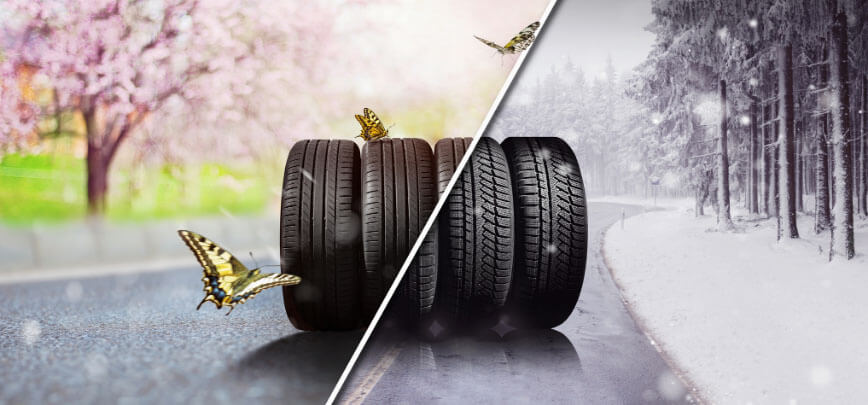Change of Season, Change of Tires
Spring has finally arrived in Canada. It’s time to put away our winter parkas, clean out the gutters and get the vehicle ready for warmer weather. Even though Spring officially starts mid-March, the beginning of the season can toggle between light flurries and brisk mornings. With Canadian weather unpredictable, a good rule of thumb to change your winter tires back to all-season tires is once the temperature consistently averages 7 degrees Celsius or above, including overnight lows.
My winter tires are sturdier. Can I use them all season long?
Some people may think that because winter tires have more tread, it can’t hurt to use them in the summer months as well. However, winter tires are made with softer rubber than summer or all-season tires, which are designed to work best in cold weather temperatures. The rubber is meant to be more flexible during cold weather, so it can grip onto snowy and icy roadways. During the summer, the roads are often smoother so the flexible rubber on winter tires is not able to easily grip the warmer pavement. The inability to properly grip the road inhibits the car’s ability to brake properly and eats away at the car’s tread at an accelerated rate.
Because the dry and warm road causes the tread to wear out faster, it makes them less effective for the following winter. Winter tires are a costly but effective investment, and you want to preserve the lifespan of your winter tires for when you need them most.
It’s a safety concern for yourself and others.
Once the temperature is sustained around 7 degrees, the best time to change your winter tires is during your regular spring maintenance tune-up by a properly trained mechanic.
Using the wrong set of tires for the season can not only be costly and compromise the performance of your vehicle but also, more important, compromise your safety and the safety of others who share the roads.
In March of this year, a woman’s vehicle was hit by a flying tire on the 401. The passenger was deemed “lucky to be alive” and although the investigation is still underway, officials believe it could be due to a winter-to-summer tire swap.
“We see a spike in wheel separations in these seasons,” says OPP Sgt. Kerry Schmidt. “The fall season and the summer season as drivers are switching from their summer tires to their winter tires and winter tires back to their summer’s.”
Who Is Liable for a lost wheel crash?
There are several contributing factors for accidents resulting from a lost wheel, making it difficult to determine who is liable. In some cases, a dealership or mechanic can be responsible for damages due to negligence, or defective parts, but this is often difficult to prove. As a vehicle owner, you are responsible to make sure you are always driving a safe vehicle. To mitigate risk, mechanics can ask you to sign a waiver for the driver to torque their tires after 50 km of driving.
If your car has been hit by a flying tire, your insurance company can cover the damages if you have comprehensive coverage on your auto policy. Comprehensive car insurance will pay for losses, other than those covered by Collision or Upset, including:
- theft
- weather damage
- perils listed under Specified Perils
- falling or flying objects
- missiles
- vandalism
If it is your wheel that has hit another vehicle, you may be sued for any serious injury or death. Your liability coverage can protect you if someone else is killed or injured or their property is damaged. It will pay for legitimate claims against you up to the limit of your coverage and will pay the costs of settling the claims.
It is paramount to change from your winter tires to protect the integrity of the wheels, but more importantly, to protect yourself and others on the road. If you have an appointment scheduled to change your winter tires, talk to a Merit insurance broker to discuss your auto policy coverages.




